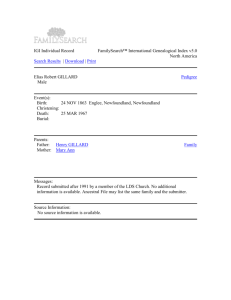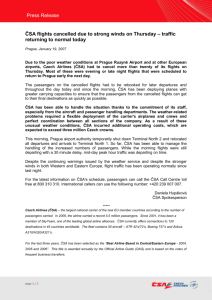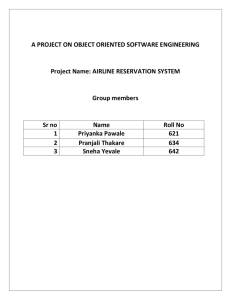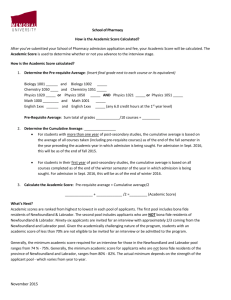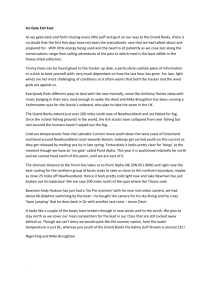Over the last weeks, I've given several speeches across the country
advertisement
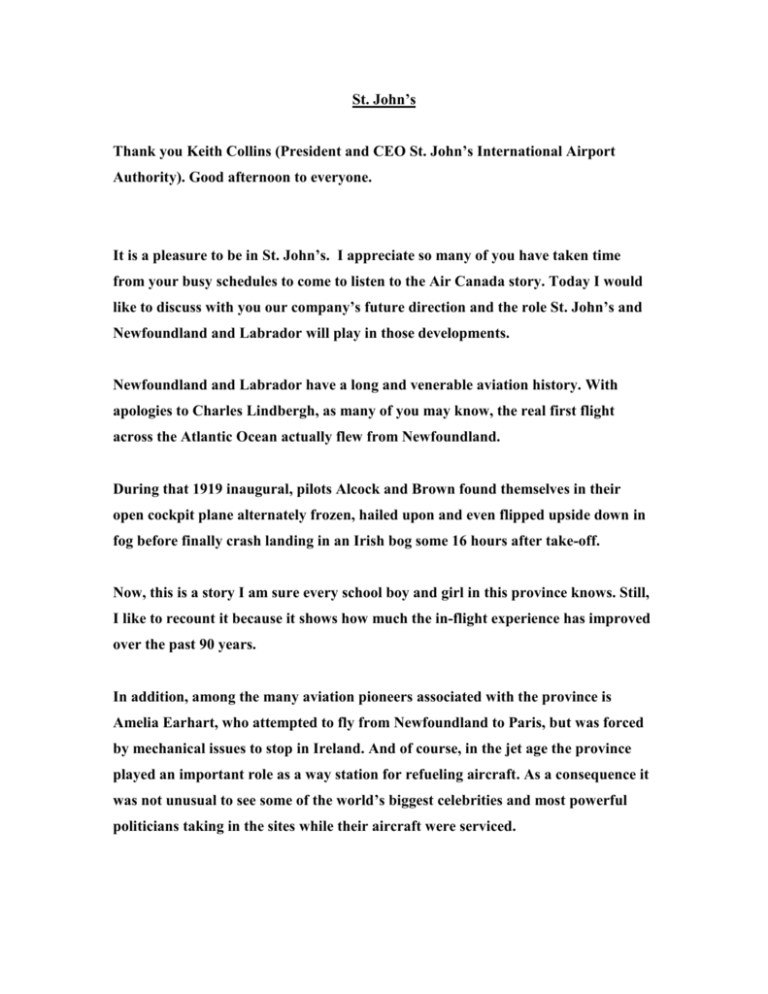
St. John’s Thank you Keith Collins (President and CEO St. John’s International Airport Authority). Good afternoon to everyone. It is a pleasure to be in St. John’s. I appreciate so many of you have taken time from your busy schedules to come to listen to the Air Canada story. Today I would like to discuss with you our company’s future direction and the role St. John’s and Newfoundland and Labrador will play in those developments. Newfoundland and Labrador have a long and venerable aviation history. With apologies to Charles Lindbergh, as many of you may know, the real first flight across the Atlantic Ocean actually flew from Newfoundland. During that 1919 inaugural, pilots Alcock and Brown found themselves in their open cockpit plane alternately frozen, hailed upon and even flipped upside down in fog before finally crash landing in an Irish bog some 16 hours after take-off. Now, this is a story I am sure every school boy and girl in this province knows. Still, I like to recount it because it shows how much the in-flight experience has improved over the past 90 years. In addition, among the many aviation pioneers associated with the province is Amelia Earhart, who attempted to fly from Newfoundland to Paris, but was forced by mechanical issues to stop in Ireland. And of course, in the jet age the province played an important role as a way station for refueling aircraft. As a consequence it was not unusual to see some of the world’s biggest celebrities and most powerful politicians taking in the sites while their aircraft were serviced. In more recent times, Gander International Airport played an integral role in world aviation in the immediate hours following the September 11, 2001, attacks when all of North America's airspace was closed. Gander’s Nav Can Centre landed 40 large jets at Gander. And the generosity and warm-heartedness of the town of 9,500 residents who housed, fed and entertained 6,600 unexpected visitors for three days has now become the stuff of legend. Air Canada has played a part in this honorable history too. Our predecessor company, Trans-Canada Airlines, began flying to St. John’s via Sydney and Gander in May 1942. That was a full seven years before another milestone event – when folks here agreed to let the Canadian Confederation join with the Dominion of Newfoundland. In those 68 years, our partnership with Newfoundland and Labrador has continued to grow and flourish. For our part, it often surprises people to learn that today Air Canada is the world’s 13th largest airline. This is even more striking when you consider Canada itself is only about 36th in terms of population among the world’s countries. So as an airline and as a country, we punch well above our weight with respect to air travel. So let me share some statistics with you. We have 26,000 employees around the world and we fly to 59 Canadian destinations, 58 in the U.S. and 60 other cities internationally. Together with Jazz, our regional partner, we operate 1,370 scheduled flights each day. Last year, we had 31 million customers – equivalent to every man, woman and child in Canada. Our direct contribution to the Canadian economy exceeds $12 billion. St. John’s and Newfoundland are very important to Air Canada. Together with our partners we operate more than 150 scheduled flights each week from St. John’s to seven destinations across Canada. We flew about 750,000 people to and from St. John’s last year – roughly one-and-a-half times the entire population of the province. We operate up to six direct flights a day to Toronto, five to Halifax, three to Gander, three to Montréal, two to Deer Lake, one to Ottawa and now one to Goose Bay. We accounted for more than 50 per cent of total passenger traffic at St. John’s International Airport. Perhaps more significantly, two of our senior officers, one of our Board members and three senior officers of our regional partner Air Canada Jazz are native sons of this province with the Rock in their blood. Air Canada and Jazz’s capacity – measured by what we term available seat miles in our industry – has increased steadily. Excluding our just newly reinstated London service, our capacity into and out of St. John’s has grown by 24 per cent between the start of 2004 and end of 2009. Moreover, traffic increased by 35 per cent over the period and last year we flew 106,000 more people than we did in 2004. And we transport more than just people. In 2009 we carried over 570,000 kilograms of freight into St John’s and over 260,000 kilograms outbound. Commodities shipped out of St John’s consist primarily of oil field equipment, live lobster and other seafood and that other highly-prized Newfoundland export, other than its people, blueberries. In terms of capacity, your airport was one of the few in Canada where Air Canada did not reduce capacity last year due to the recession. This reflects the ongoing buoyancy and vibrancy of this province’s economy, which is now largely powered by investments in oil and gas and mining. It also demonstrates our commitment to ensure air service keeps pace with demand and I know the Government of Newfoundland is keenly interested in further developing air services over the next five years. The economy is expected to remain strong and I am sure it escaped no one here when the Conference Board of Canada predicted last month that Newfoundland and Labrador would lead the country in economic growth next year. Because airlines are tied so tightly to the economy, this bodes well for our future partnership. The stronger you are – the stronger we can be and vice versa. As you know, last week we resumed our St. John’s-London service and we have added a new flight from St. John’s to Goose Bay. We will continue to look for opportunities but will need strong support from local business and leisure travelers to make these opportunities work from a financial viewpoint. But our presence in Newfoundland and Labrador is about much more than filling seats. We have a mutually beneficial relationship in that Air Canada is a big employer with approximately 130 people in St. John’s, with payroll and benefits of nearly $8 million a year. We also spend about $45 million annually in the province on goods and services and the spin-off annual economic impact of Air Canada in Newfoundland and Labrador amounts to $180 million a year based on the usual economic impact assessment criteria. Air Canada employees are also active in your community. Through Dreams Take Flights, our employee-led organization, disadvantaged children from Newfoundland are flown to Disney every year for a day of magical memories. Additionally, in partnership with the Janeway Children’s Hospital Foundation, our Kids Horizons Program transports children to medical facilities across Canada so they can access care not available locally. Air Canada’s Kids' Horizons also contributes to the fundraising efforts of a wide range of local and grass-root charities, including The Burin Peninsula Health Care Foundation and the Boys and Girls Wish Foundation. So, while I may be a “come from away” and this is my first visit to St John’s since my appointment last April, Air Canada is very present in this community all the time. Now, let me tell you a bit about where we’ve been, where we are and where we’re going. The airline sector is one of the most challenging in the world. There is intense competition, high costs, it is hyper-sensitive to economic change and it can be thrown into disarray by bad weather, volcanoes, earthquakes, underwear bombers, pandemics and conflict or natural disasters happening anywhere in the world. Last year, with the economic downturn, the global airline industry saw the worst drop in revenue since the Second World War. The International Air Transport Association estimates the global industry lost $10 billion in 2009 and, despite signs of recovery, may lose another $2.8 billion this year. Air Canada is not immune to these effects and these have been difficult times. However, based on the very strong efforts of our management team and all of our employees and partners, we have now stabilized our company – we extended all of our collective agreements, we dealt with our pension deficit for five years and most importantly, we raised $1 billion in liquidity in July and raised another $250 million in new equity last year despite the turmoil in the stock markets. And we are now focused on the future. So what does that future look like? Following a luncheon discussion with a group of other Canadian CEOs recently I’ve started to challenge the organization to see if we have what it takes to be a truly Global Champion. These are companies that not only excel, but consistently excel, from year-to-year. The AT Kearney 2009 list of 25 Global champions includes companies from the U.S., South Korea, Japan, Europe and even South Africa. No Canadian company made the list and none of the companies listed were airlines. What distinguished this select group is that they generated nearly 15 per cent value growth annually for the past five years. To become a global champion requires taking some risk, seizing new opportunities, innovating and expanding with a clear vision for the future. On the whole, Global Champions pursue a growth strategy that balances economic, environmental and social considerations. Size does not matter but strong leadership, staying focused on the end goal and an ability to shift gears under changing circumstances are required. At Air Canada, we have established four priorities that I believe put us on track to becoming a global champion Whether we are actually ever recognized as a Global Champion is almost secondary – it is the aspiration and ethos of continuous improvement that matters. Already, we are seeing very encouraging results and I hope that you who are our customers are seeing results as well. As with any structure, you start with the foundation. For a corporation that means finances have to be put in order. So our first priority is our Cost Transformation Program aimed at achieving $500 million in annual cost and revenue improvements by the end of 2011. Already, we have achieved $255 million of our $270 million target for 2010, so we are right on track. Importantly, we are doing this without compromising the customer experience or through employee reductions but instead through better processes, new technology and by being creative. Next, we have to play to our strengths. We are not a low-cost carrier – we are a fullservice airline with legacy strengths and legacy costs. Our second priority then is to transform the way we engage with our customers, with particular emphasis on our premium business travellers. We know that no one owes us a living – we are not entitled to your business – we must earn it First, we have to hear what you are saying. So we are doing this through new communication tools, by holding face-to-face meetings with our top tier customers. And we have done this virtually coast to coast, starting in Vancouver and ending this morning here in St John’s. We are meeting our customers so we can listen and improve and we are ensuring our front-line employee workforce becomes more engaged and intent on showing what we can do. More tangibly, we have invested in products such as our Lie-flat suites in international business class that lead the industry. Our top of the line in-flight entertainment system on the back of each seat shows films that are still in theatres. Our Maple Leaf Lounges and our Concierge Program make the airport experience significantly more pleasant for our most frequent travelers. Aeroplan consistently is amongst the highest ranked airline rewards programs worldwide. Conversely, we admitted straight up that certain irritants were bothering customers. We eliminated the call centre fee. We increased the availability of Aeroplan reward seats. We allowed small pets back in the cabin. We improved our Super Elite members’ access to revenue seats. And we reached out to the travel trade community to restore commissions on some of our lower fare categories. While our effort to re-engage customers is still very much a work in progress, I was extremely pleased when the most frequent travelers in the industry, including our own customers, recognized what we are achieving. In late 2009, we won a series of prestigious awards from Business Traveler and Global Traveler , two international magazines that are, in effect, the Academy Awards of our industry, based on extensive surveys of many different carriers. These awards included: Best Flight Attendants in North America; Best In-flight Services in North America; Best Business Class among North American carriers; Best North American Airline for International Travel. Best Airline in Canada, and Best Airline in North America. The most significant accolade as far as I am concerned is the one received earlier this month when the independent research firm Skytrax ranked Air Canada Best Airline in North America after an exhaustive survey of more than 17 million air travelers from 100 different countries. Skytrax is a globally recognized and respected firm and it used more than 35 different aspects of passenger satisfaction to compare airlines’ product and service standards. So let me pause here. Despite the many challenges we faced in 2009, contrary to urban legend, Air Canada is the Best Airline in North America. The third element of our transformation will require overcoming what I consider our greatest challenge: changing the culture at Air Canada. This must happen both in terms of how customers see us and how we behave as a company. This is the most important aspect of our transformation – a corporate culture sets the tone for everything that you do. With the right drivers – both in terms of people and tools – Air Canada will absolutely become a more entrepreneurial and nimble company. A big company that behaves more like a small company, with simpler processes, fewer committees, less paralysis by analysis. A place where employees are empowered and able to make decisions. A place with a “Just Do It” culture. A very good recent example of this was our handling of the Icelandic volcano’s shut down of European operations for the better part of a week in April, stranding thousands of our passengers. We were among the first carriers to resume operations and in many cases we were able to carry passengers stranded by other airlines. And there’s a local angle to this – in the midst of the volcanic activity, St. John’s was hampered by severe weather and fog (surprise, surprise) just as virtually every major Canadian music artist was scheduled to travel here for the Juno Awards weekend. Complicating matters, Gander, the alternate airport was also below limits for operation. While other airlines simply cancelled flights or returned to their origin points, thanks to the strategic plan put together by our Operations and Airports teams, our flights were the first to arrive in St John’s that afternoon with Juno customers by several hours! Our team at St John’s had been in constant communication with the Juno Executive Committee, keeping them apprised of our efforts and plans. Simple. Teamwork. Strength of a big company behaving like a small one. The fourth element of our transformation entails building on our position as one of the world’s leading international carriers. As I said, Air Canada is the 13th largest airline in the world. We benefit from Canada’s excellent geographic position. We have a vast network underpinned by an array of bilateral authorities to fly to other countries, and, more than this, we are a founding partner of the 27-member Star Alliance, the largest global airline network. It enables us to seamlessly connect passengers with carriers that fly to nearly 1,200 airports in 180 countries and this connecting traffic drives growth. For example, Brussels Airlines’ admission to Star Alliance last year made it attractive for Air Canada to begin flying to Brussels. This opened not only another European gateway for customers, but also a convenient connecting point for travel between Canada and Africa, which is well served by Brussels Airlines. In addition to Star, we have joined with Lufthansa, United Airlines and Continental Airlines to form Atlantic-Plus-Plus, a venture through which each carrier sells seats on the other as if we were one large airline with a single network. This results in new routes and city-pairings as we integrate our route maps to connect traffic flowing between the four partners. Since last year we have already added or announced new service to Geneva, Rome, Brussels, Athens and Barcelona that will strengthen our European flagship routes of London, Paris and Frankfurt. In March, we launched our first Calgary-Narita flight and last week we re-launched our St. John’s-London service. Understandably, there has been much interest and some concern about our service from St. John’s to London Heathrow. We know the community values this international connection for business, tourism and leisure travel. I know I would if I lived here. And I am well aware that there has been a long and historic direct connection between Newfoundland and Labrador and London. And here let me pause to acknowledge the tremendous support of Keith Collins and his team at the St. John’s International Airport for their support and cooperation which was essential to get this route re-started. However, for this route to work on a viable and sustainable basis, it will need even stronger support from the community than we are seeing. We view this summer as a good test upon which to make future determinations about this service. Flying longer haul routes such as London carries significant risk, as the flights must be full – in both directions – at appropriate yields. Governments, the Airport Authority, the tourism associations and the travel trade who have advocated for the resumption of this flight will certainly have a role to play as our partners in this initiative. For our part, to facilitate connections and increase traffic, we have allocated good landing slots for this flight in London – where slots are controlled and limited, and are valued at a premium. The flight’s timing out of St. John’s is also attractive and timed for local connections. In addition, we have invested in the service. For example we spent more than $6 million in training and specially outfitting the A319 aircraft that operate this flight because of the extended flight time over water the route requires. We are also committed to ongoing marketing and promotion. But at the end of the day we are a business and any route has to be economically sustainable. Air Canada has what it takes to become a Global Champion and the country, including Newfoundland and Labrador, will benefit. As we’ve noted, there is a direct and very strong correlation between air connectivity and economic growth. Our taking some risk is good for the community; the community’s growth should be good for Air Canada. As I hope I have convinced you today, we are indeed seizing opportunities, innovating with new products both on and off our aircraft, we are expanding both organically and through our global partners, and we have a clear vision for the future of our company. It has been a pleasure to speak with you this afternoon. I look forward to sharing many more years of success with the St. John’s and the Newfoundland and Labrador’s business community and to keep finding ways to build on each other’s strengths. Thank you


